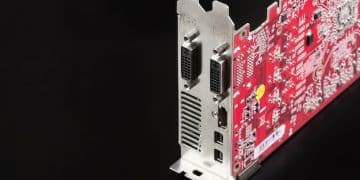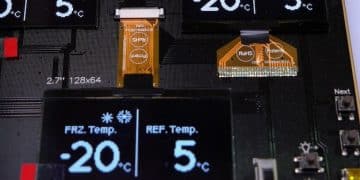AMD Open Source: Benefits for Gamers & Developers

AMD’s open-source approach fosters innovation, customization, and cost-effectiveness for both gamers and developers by providing access to source code, enabling community-driven improvements and tailored solutions in gaming and software development.
The world of gaming and software development is constantly evolving, and **AMD’s Open Source Approach: How it Benefits Gamers and Developers in the Long Run** is at the forefront of this evolution. By embracing open source, AMD empowers developers and gamers alike with unparalleled flexibility, customization, and performance enhancements. Let’s explore how this strategy reshapes the landscape and what it means for the future.
Understanding AMD’s Commitment to Open Source
AMD has increasingly championed open-source initiatives, transitioning from proprietary solutions to a more inclusive and collaborative ecosystem. This shift reflects a commitment to transparency, community involvement, and the advancement of technology for everyone.
Why Open Source?
The decision to embrace open source is strategic. It allows AMD to leverage the collective intelligence of the developer community, resulting in faster innovation and more robust solutions. It also aligns with the broader industry trend toward open standards and interoperability.
Open source means that developers have access to the source code of AMD’s technologies, enabling them to modify, distribute, and enhance it. This fosters a vibrant community of contributors who can identify and fix bugs, optimize performance, and add new features that might not have been possible within a closed ecosystem.
- Enhanced Customization: Developers can tailor AMD’s technologies to meet specific needs.
- Faster Innovation: The community can rapidly iterate and improve upon existing solutions.
- Increased Transparency: Open source promotes trust and accountability.
- Wider Adoption: Open standards facilitate compatibility and interoperability.

In conclusion, AMD’s commitment to open source is driven by a desire to foster innovation, enhance transparency, and empower both developers and gamers with more control over their technology.
Benefits for Gamers: Enhanced Performance and Customization
Gamers stand to gain substantially from AMD’s open-source initiatives. Access to open-source drivers and tools allows for greater customization and optimization, resulting in improved performance and a more personalized gaming experience.
Driver Optimization
Open-source drivers mean that gamers and developers can work together to optimize the performance of AMD GPUs for specific games. This collaborative approach can lead to significant performance improvements compared to relying solely on proprietary drivers.
For instance, community-driven optimizations can address specific bottlenecks or compatibility issues that might not be prioritized by AMD in its official driver releases. This ensures that gamers can enjoy the best possible experience, regardless of the game they are playing.
Customization Options
Open-source tools also provide gamers with greater control over their hardware. They can tweak settings, monitor performance, and even modify the behavior of their GPUs to suit their individual preferences. This level of customization is simply not possible with closed-source solutions.
- Increased Frame Rates: Optimizations can lead to smoother gameplay and higher frame rates.
- Reduced Latency: Fine-tuning can minimize input lag and improve responsiveness.
- Improved Stability: Community-driven bug fixes can enhance system stability.
- Personalized Experience: Gamers can tailor their hardware to their specific needs.
In summary, AMD’s open-source approach empowers gamers with enhanced performance and customization options, allowing them to get the most out of their hardware and enjoy a more personalized gaming experience.
Advantages for Developers: Flexibility and Innovation
Developers benefit immensely from AMD’s open-source strategy. The availability of open-source tools and libraries provides them with the flexibility to create innovative solutions and optimize their software for AMD hardware.
Access to Source Code
Having access to the source code of AMD’s technologies allows developers to understand how they work at a fundamental level. This knowledge enables them to optimize their software for AMD hardware and create innovative solutions that would not be possible with closed-source tools.
For example, developers can use the open-source ROCm platform to accelerate their machine learning workloads on AMD GPUs. By understanding the inner workings of ROCm, they can fine-tune their code to achieve maximum performance and efficiency.
Community Collaboration
Open source fosters a collaborative environment where developers can share their knowledge, contribute to projects, and learn from each other. This collaborative spirit leads to faster innovation and more robust solutions.
- Faster Development Cycles: Collaboration accelerates the development process.
- Higher Quality Code: Community review ensures code is robust and reliable.
- Wider Range of Applications: Open source encourages diverse applications.
- Greater Innovation: Collaboration sparks new ideas and approaches.

In conclusion, AMD’s open-source approach provides developers with unparalleled flexibility and fosters a collaborative environment that drives innovation and leads to the creation of more robust and efficient software solutions.
AMD’s ROCm Platform: A Deep Dive
ROCm (Radeon Open Compute platform) is AMD’s open-source software platform for GPU-accelerated computing. It provides developers with a comprehensive set of tools and libraries for building high-performance applications in areas such as machine learning, scientific computing, and data analytics.
Key Features of ROCm
ROCm supports a variety of programming languages, including C++, Python, and HIP (Heterogeneous-compute Interface for Portability). It also includes libraries for linear algebra, signal processing, and other common computational tasks.
One of the key features of ROCm is its support for heterogeneous computing, which allows developers to seamlessly integrate CPU and GPU resources to maximize performance. This is particularly important for applications that require both high compute power and low latency.
Benefits of Using ROCm
Using ROCm offers several advantages for developers. It provides access to the full potential of AMD GPUs, enabling them to achieve significant performance gains compared to CPU-only solutions. It also allows them to target a wide range of hardware, from desktop GPUs to high-performance computing clusters.
- High Performance: ROCm unlocks the full potential of AMD GPUs.
- Broad Hardware Support: ROCm supports a wide range of AMD hardware.
- Open Source: ROCm promotes collaboration and innovation.
- Comprehensive Toolset: ROCm provides a complete set of development tools.
In summary, ROCm is a powerful open-source platform that empowers developers to harness the power of AMD GPUs for a wide range of computationally intensive tasks, driving innovation and enabling new possibilities in various fields.
The Impact on Linux Gaming and Development
AMD’s open-source approach has had a particularly significant impact on Linux gaming and development. The availability of open-source drivers and tools has made it easier for developers to create and optimize games for the Linux platform, while also improving the gaming experience for Linux users.
Open Source Drivers
AMD’s open-source drivers for Linux have been instrumental in improving the gaming experience on this platform. These drivers provide excellent performance and compatibility, allowing Linux gamers to enjoy the latest titles without sacrificing performance or stability.
In addition, the open-source nature of these drivers means that the community can contribute to their development, fixing bugs and adding new features that might not be prioritized by AMD. This ensures that Linux gamers have access to the best possible drivers.
Development Tools
AMD’s open-source development tools have also made it easier for developers to create and optimize games for Linux. These tools provide a comprehensive set of resources for profiling, debugging, and optimizing code for AMD hardware.
- Improved Performance: Open-source drivers optimize gaming on Linux.
- Better Compatibility: Open-source drivers enhance Linux game compatibility.
- Easier Development: Open-source tools simplify Linux game development.
- Community Support: The community improves Linux gaming through open source.
In conclusion, AMD’s open-source approach has significantly improved the landscape for Linux gaming and development, making it easier for developers to create high-quality games and for gamers to enjoy a seamless and optimized gaming experience on the Linux platform.
Challenges and Future Directions
While AMD’s open-source approach offers numerous benefits, it also presents certain challenges. Maintaining compatibility across different hardware configurations and ensuring that open-source drivers and tools are as robust and reliable as proprietary solutions requires significant effort.
Ensuring Compatibility
One of the key challenges is ensuring compatibility across a wide range of hardware configurations. AMD’s GPUs are used in a variety of systems, each with its own unique hardware and software environment. Maintaining compatibility across all these systems requires extensive testing and validation.
Another challenge is ensuring that open-source drivers and tools are as robust and reliable as proprietary solutions. This requires a dedicated team of developers and testers who can identify and fix bugs, optimize performance, and ensure that the software meets the highest standards of quality.
Future Directions
Looking ahead, AMD is committed to further expanding its open-source initiatives and addressing these challenges. The company plans to continue investing in its open-source drivers and tools, as well as working closely with the community to improve their quality and compatibility.
- Continued Investment: AMD is dedicated to open-source development.
- Community Engagement: AMD will collaborate with the open-source community.
- Improved Compatibility: AMD aims for better hardware compatibility.
- Enhanced Reliability: AMD strives for robust and reliable open-source solutions.
In summary, while challenges remain, AMD’s commitment to open source is unwavering. By continuing to invest in its open-source initiatives and working closely with the community, AMD aims to overcome these challenges and unlock the full potential of open source for both gamers and developers.
| Key Point | Brief Description |
|---|---|
| 🎮 Gaming Benefits | Enhanced performance and customization for gamers through open-source drivers. |
| 👩💻 Developer Flexibility | Developers gain flexibility with open-source tools, enabling innovation and optimization. |
| 🚀 ROCm Platform | ROCm accelerates GPU computing, offering comprehensive tools for developers. |
| 🐧 Linux Impact | Open-source drivers and tools significantly improve Linux gaming and development. |
Frequently Asked Questions
▼
AMD’s open-source approach involves providing access to the source code of its technologies, allowing developers and users to modify, distribute, and enhance them. This promotes collaboration and innovation within the tech community.
▼
Open-source drivers and tools allow gamers to optimize their hardware for specific games, leading to increased frame rates, reduced latency, and improved stability. It also enables personalized gaming experiences.
▼
Developers benefit from the flexibility to create innovative solutions, access to source code for optimization, and community collaboration, resulting in faster development cycles and higher quality code.
▼
ROCm is AMD’s open-source software platform for GPU-accelerated computing. It provides developers with tools and libraries for high-performance computing in machine learning, scientific computing, and data analytics applications.
▼
AMD’s open-source drivers and tools have significantly improved Linux gaming and development by enhancing performance, compatibility, and simplifying game development, leading to a better gaming experience on Linux.
Conclusion
AMD’s commitment to open source is a game-changer for both gamers and developers. By embracing transparency, collaboration, and community-driven innovation, AMD is not only enhancing the performance and customization options available to users but also fostering a more vibrant and dynamic ecosystem for software development. As AMD continues to invest in open-source initiatives and work closely with the community, the benefits for gamers and developers are only set to grow, solidifying AMD’s position as a leader in the industry.





